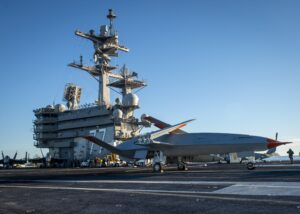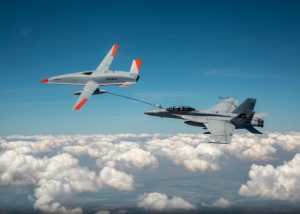Production challenges have pushed the initial operational capability (IOC) of the Navy’s MQ-25A Stingray unmanned carrier-based tanker back a year to 2026, a program executive said last week.
Speaking during the Navy League’s Sea Air Space symposium on April 3, Rear Adm. Stephen Tedford, Program Executive Officer for Unmanned Aviation and Strike Weapons, said the current scheduled plan for MQ-25 IOC is 2026.

Previously, the Navy planned to reach IOC in 2025 and then deploy the first operational aircraft aboard the USS Theodore Roosevelt (CVN-73) by 2026.
“We are experiencing some production maturity challenges with the MQ-25. I think most people don’t quite realize just how big the MQ-25 actually is…it’s about as long as an F-18 with a wingspan of an E-2. Okay, it is not a small UAV by any means,” Tedford said.
Boeing [BA] is the prime contractor for the Stingray, having won an initial $805 million engineering and manufacturing development contract in 2018 covering the design, development, building, testing and verification of the first four MQ-25s (Defense Daily, Aug. 30, 2018).
Then in 2020, the Navy awarded an $85 million modification to procure three more system demonstration test article aircraft (Defense Daily, April 3, 2020).
In September 2022, the Navy awarded Boeing a $47 million advance acquisition contract to prepare to build and deliver the low-rate initial production (LRIP) Lot 1 MQ-25s. Lot 1 is planned to include four Stingray tankers (Defense Daily, Sept. 30, 2022).
The Navy plans to ultimately procure 76 MQ-25s including four engineering development models and three system demonstration test articles
While IOC is now set at 2026, originally IOC was set for FY ‘26, then the Navy pushed that up to 2024, then delayed it a year to 2025 before settling more recently on the original 2026 date.
In 2021, the Navy conducted deck handling operation tests with the first MQ-25 test asset built by Boeing, called T-1, aboard the USS George H.W. Bush (CVN-77). That test involved no flight operations (Defense Daily, Dec. 20, 2021).
Tedford said the Navy is going through a fixed-size determinate assembly production schema for the first time which is resulting in some challenges “ which is actually what’s kind of holding us back a little bit in getting the production to where we need it.”
The next step for MQ-25 is what the program office called “Stingray to the Fleet’ which will field “anywhere from three to five platforms” on an unspecified aircraft carrier “in a permissive environment only and providing and taking over the tanking roles away from the F-18s so that they can get back to the fight.”
Currently, F/A-18E/F Super Hornets are conducting tanking roles so the MQ-25 is meant to relieve them, giving the Navy more strike usable fighters.
After that basic carrier integration phase, the next step is ‘Stingray to the Fight’ as a “non-permissive environment solution set.”
Tedford said to reach that stage the Navy needs to understand how to incorporate deck control, launch and recovery “with [low probability of intercept/low probability of detection (LPI-LPD)] waveforms? How are we going to control it airborne and how can I also use it as a comm network node once it’s on station with other platforms? But it has to be operationally adaptive to multiple environments, and be able to work with multiple operating systems.”

He underscored the MQ-25 cannot be restricted to only being able to talk to an F/A-18E/F Super Hornet because they both happen to be made by Boeing, but various platforms and partner countries need to be able to interface with the tanker.
“MQ-25 needs to have the ability to talk and be managed by any airborne platform, including those of our allies and partners. That’s that open architecture piece that we need to be able to get after, and we need the industry’s help, to help us figure out how best to do that, and to be able to do it quickly at speed. Not the speed that our normal Acquisition System likes to hold us back in.”
Last September, Boeing announced it conducted a digital simulation of an open autonomy architecture that allowed digital versions of manned Super Hornets, P-8A Poseidon maritime patrol and reconnaissance aircraft, and a Northrop Grumman [NOC] E-2D Advanced Hawkeye command and control aircraft to task four virtual autonomous MQ-25s (Defense Daily, Sept. 6, 2022).
At the time, the company said the non-proprietary architecture showed how those kinds of aircraft could task Stingrays for tanking as well as intelligence, surveillance and reconnaissance (ISR) missions without traditional communications via a ship-based ground control station.
The MQ-25 is expected to be able to pass 15,000 pounds of gas at up to 500 miles from the carrier at around 25,000 feet.
The Navy’s FY ‘24 budget request includes three MQ-25s at a cost of $596 million.